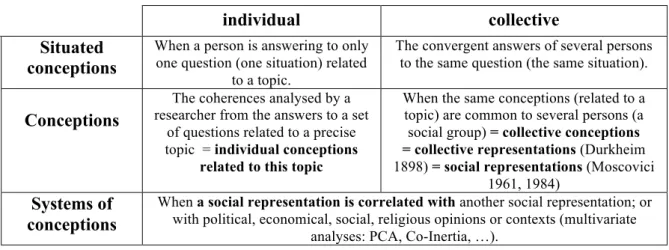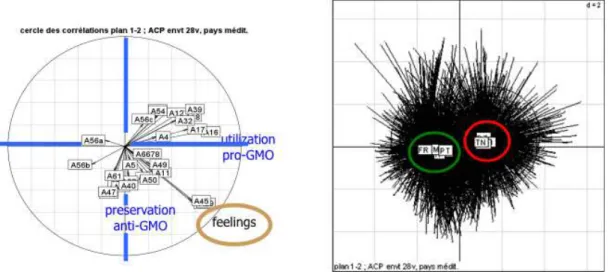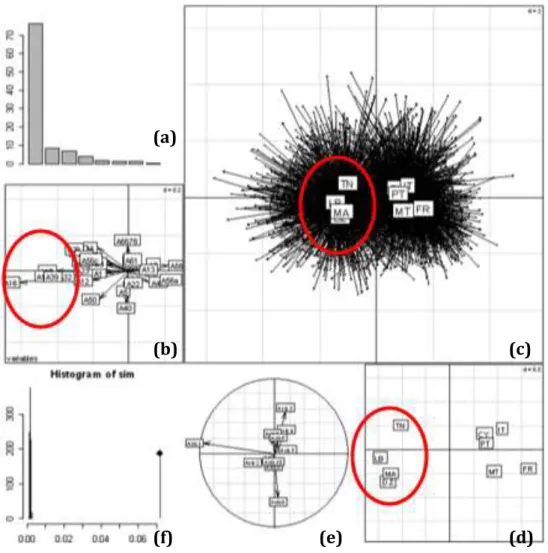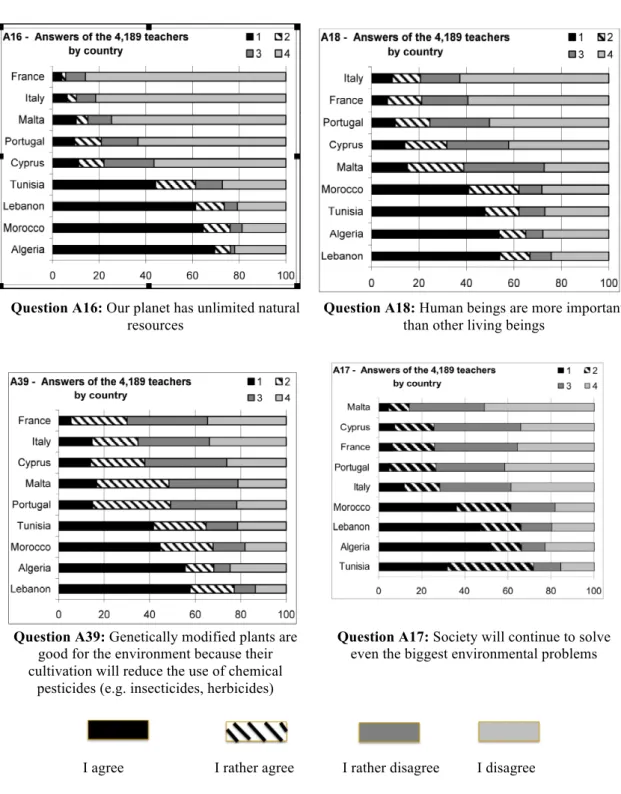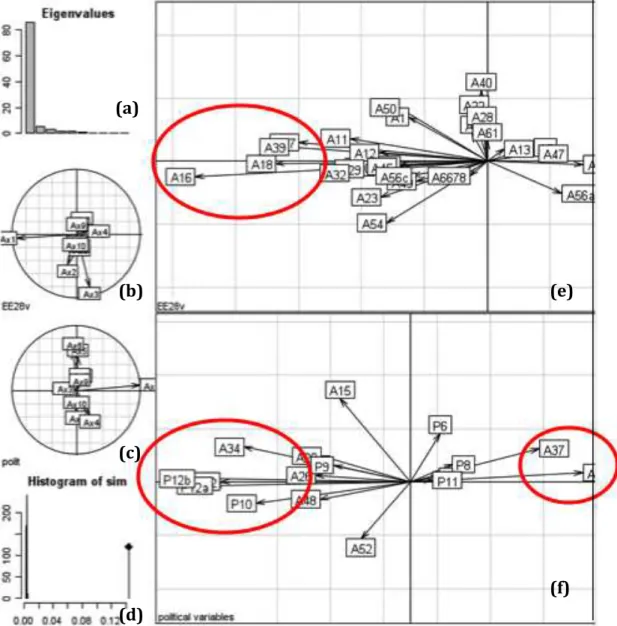HAL Id: hal-01054238
https://hal.archives-ouvertes.fr/hal-01054238
Submitted on 5 Aug 2014
HAL is a multi-disciplinary open access archive for the deposit and dissemination of sci-entific research documents, whether they are pub-lished or not. The documents may come from teaching and research institutions in France or abroad, or from public or private research centers.
L’archive ouverte pluridisciplinaire HAL, est destinée au dépôt et à la diffusion de documents scientifiques de niveau recherche, publiés ou non, émanant des établissements d’enseignement et de recherche français ou étrangers, des laboratoires publics ou privés.
Teachers’ conceptions concerning the environment
across nine Mediterranean countries
Pierre Clément, Silvia Caravita, Adriana Valente, Loredana Cerbara, Charline
Laurent
To cite this version:
Pierre Clément, Silvia Caravita, Adriana Valente, Loredana Cerbara, Charline Laurent. Teachers’ conceptions concerning the environment across nine Mediterranean countries. ERIDOB 2010, 2010, Braga, Portugal. �hal-01054238�
Clément P., Caravita S., Valente A., Cerbara L., Laurent C. (2010). Teachers’ conceptions concerning the environment across nine Mediterranean countries. Oral communication in ERIDOB, Braga (Portugal).
TEACHERS’ CONCEPTIONS CONCERNING THE ENVIRONMENT ACROSS NINE MEDITERRANEAN COUNTRIES
Pierre Clément*, Silvia Caravita**, Adriana Valente**, Loredana Cerbara**, Charline Laurent*
• University Lyon 1, France • CNR, Roma, Italy
Pierre.Clement@univ-lyon1.fr
Abstract
Mediterranean countries share the same climate, the same nature and the same roots of civilization. Nevertheless they differ in socio-political aspects, economical development and religions. Are the teachers’ conceptions on Environment linked to some of these parameters? Our research, held in the context of the BIOHEAD-Citizen project « Biology, Health and Environmental Education for better Citizenship », analysed the answers of 4189 teachers from nine Mediterranean countries to a questionnaire dealing with some topics of Environment: utilization, protection, GMO, feelings of animals, …
Multivariate analyses show great divergences among the teachers’ conceptions, several inside each country and some differentiating the countries.
In countries from the South of Mediterranean Sea (Morocco, Algeria, Tunisia, Lebanon), the teachers’ conceptions are more anthropocentric and more pro-GMO than in European Mediterranean countries (Cyprus, Malta, Italia, France, Portugal).
The anthropocentric conceptions from the South Mediterranean countries are correlated with a low economical development, but also with a high degree of believing in God and practising religion (with no difference among religions) and with some socio-political positions more “at right” and against secularism.
These correlations between knowledge, values and attitudes related to Environment are to be taken into account to improve the Environmental Education in each country.
Key-words: Teachers’ conceptions – Environment – North and South countries – Religion – Political positions -
Acknowledgements
This work has been supported by the European Research Project Biohead‐Citizen (Specific Targeted Research n° 506015, FP6, Priority 7: "Biology, Health and Environmental Education for better Citizenship"). The authors specially thank the other colleagues who gathered data from their country:
Sabah Selmaoui, Boujemaa Agoram, Salahedine Khzami (Morocco), Farida Khammar, Amaria Aouar-Métri (Algeria), Mondher Abrougui, Alaya Alaya (Tunisia), Paul Pace (Malta), Iman Khalil, Fadi Haje (Lebanon), Nicos Valanides, Olia Nisiforou (Cyprus), Jérémy Castéra, Sandie Bernard, Dominique Berger, Marie-Pierre Quessada (France), Graça Carvalho, Rosa-Branca Tracana (Portugal).
1. Introduction
Mediterranean countries share the same roots of civilization and their cultural histories have been enriched by a ceaseless and intense array of material and non-material exchange.
A greater awareness of the interdependence of society and nature and the urgent need of improving its management should be a goal for countries with so much in common.
Although they share many similar characteristics (climate, nature, but also several successions of culture), Mediterranean countries differ in many respects: geographical and political conditions, social organization, lifestyle, economic development, and religion — to quote the most outstanding examples —.
Callicott, who surveyed ecological ethics from the Mediterranean basin to the Australian outback, highlighted how a community is embedded in nature according to its characteristics and that cultural behaviours include codified ways of relating to nature. However, the forces of globalization not only threaten biological diversity, but cultural diversity as well (Callicott, 1994).
Therefore our investigation asks the following:
• Within Mediterranean countries, what are the beliefs, values, and world views of teachers concerning their relationship with the environment?
• Are their views (their conceptions on Environment) diverse, depending the country or other parameters?
This research was held in the context of the BIOHEAD-Citizen European research project « Biology, Health and Environmental Education for better Citizenship » (2004-2008), coordinated by G. Carvalho (Portugal), P. Clément (France) and F. Bogner (Germany). Environmental Education was one of the six topics of this project, which concerned 19 countries, nine of them being located around the Mediterranean Sea: Morocco, Algeria, Tunisia, Malta, Lebanon, Cyprus, Italia, France, Portugal.
2. Theoretical background
A wide range of educational aims addressed current challenges concerning the environment, sustainability: for instance Giolitto & Clary, 1994; Sauvé, 1995; Sauvé & Girault, 2008; Schultz & Zelezny, 1999; Berthou et al., 2008; Caravita et al., 2008.
These authors agree that knowledge, skills, and values must be addressed together within environmental education because of their significant level of interaction within one's mental processes that shape learning. “A topic that has received increasing attention in science
education is the world view theory (Cobern, 2000) (….) students’ beliefs in the study of science are influenced by the world views commonly held in their socio-cultural environments” (Murphy & Mason, 2006). Are there different world views around the
Mediterranean Sea?
We analyse the teachers’ conceptions as possible interactions between their Knowledge, Values and Practices: the KVP model (Clément, 2004a, 2006). Values function as an organized system: the meaning of a particular value functions as part of the ethical field to which it belongs. The various categories of values related to Environment have been discussed in the BIOHEAD–Citizen project (Caravita et al., 2008), especially as they pertain to different dimensions of human activity related to our relationship with the environment or ways of viewing nature. Forissier and Clément (2003) and Clément (2004b) traced the roots of conceptions about nature in both spiritualism and materialism. They showed how both can
result in opposing ends: radical ecologism (biocentric attitudes) on one extreme and unlimited exploitation (anthropocentric attitude) on the other.
Stern and Dietz (1994) proposed that there are three distinct categories of environmental attitudes: the individual, society-at-large, and all living beings, which correspond to egoistical, social, and biocentric attitudes. More authors are speaking about anthropocentric, ecocentric and biocentric attitudes (Theys 1993, C. Larrère 1997), with a main focalisation on the anthropocentric and ecocentric views (Schultz et al., 2000). These two categories correspond to two poles defined by Wiseman & Bogner (2003) (the model 2-MEV) when analysing students' conceptions on environment: utilisation and preservation, also found in the teachers’ conceptions in the BIOHEAD-Citizen project (Munoz et al., 2009).
A third pole (sentimentocentric) has been defined in this project, as teachers’ ideas about the capacity of animals to feel or not dolour or happiness: in France, Germany and Portugal (Forissier, 2003, Forissier & Clément, 2003), in Lebanon (Khalil et al., 2007), in Algeria (Khammar et al., 2008) and in Morocco (Khzami et al,. 2008).
Another pole is linked to the GMO, with animated debates generally structured by an opposition vs. acceptation of GMO (Clément et al., 2007). According to European Commission (Eurobarometer, 2008) public opinion survey, the majority of Europeans (58%) are opposed to the use of GMOs (Genetically Modified Organisms). The resistance is more important in some countries as Cyprus (82%) than in other ones as Malta (28%) or Portugal (28%). In most of the European countries, the acceptance or reject of GMO is a controversial issue, opposing divergent scientific arguments generally linked to different opinions (Berlan & Lewontin 1986, Kempf 2003, Bonneuil et al. 2008).
What are the teachers’ conceptions related to GMO around the Mediterranean Sea?
3. Methodology
The total sample (4 189 teachers) comes from nine Mediterranean countries: Morocco (330), Algeria (223), Tunisia (753), Malta (198), Lebanon (722), Cyprus (322), Italy (559), France (732) and Portugal (350).
In each country, it is a well balanced proportion of six sub-samples: • 1/3 Primary School teachers (1/6 in-service and 1/6 pre-service)
• 1/3 Biology teachers in Secondary Schools (1/6 in-service and 1/6 pre-service) • 1/3 Language teachers in Secondary Schools (1/6 in-service and 1/6 pre-service)
Each teacher filled out a large questionnaire (144 questions), including • 29 questions related to Environment, GMO, Environmental Education
• 17 questions related to personal information (age, gender, ... but also religion, religious practice, political or social opinions, ...).
The questionnaire was built by a collective work during more than 2 years (Clément & Carvalho, 2007, Caravita et al., 2008):
• A longer pilot test using already validated questions and some new ones • Translations and validation of the translations in each country
• Application of the pilot test to small samples in most of the countries • Complements by interviews
• Validation of the reliability of questions (the same students one month after)
All the teachers had to individually fill out the 144 questions of the questionnaire (10 pages), with a total guarantee of anonymity. It took between 30 to 45 minutes.
They did that at the end of a course for the pre-service and some in-service teachers, and in their school for the other in-service teachers. The teachers were in groups when filling out the questionnaire, in presence of the researcher who immediately gathered the filled questionnaires. The data from each country were then put in an Excel file and analysed in Lyon (France) with multivariate analyses using the free software “R” (Munoz & Clément, 2007; Munoz et al., 2009).
The questions related to Environment were selected from precise hypotheses, each set of questions (tables 2, 3, 4 & 5) corresponding to a precise topic. To analyse the answers, we used the concepts defined in the table 1.
Table 1: Definition of the concepts used to define the teachers’ conceptions
individual collective Situated
conceptions
When a person is answering to only one question (one situation) related
to a topic.
The convergent answers of several persons to the same question (the same situation).
Conceptions
The coherences analysed by a researcher from the answers to a set
of questions related to a precise topic = individual conceptions
related to this topic
When the same conceptions (related to a topic) are common to several persons (a social group) = collective conceptions
= collective representations (Durkheim
1898) = social representations (Moscovici 1961, 1984)
Systems of conceptions
When a social representation is correlated with another social representation; or with political, economical, social, religious opinions or contexts (multivariate
analyses: PCA, Co-Inertia, …).
Table 2 - The questions related to the topic "Preservation” (ecolocentric conceptions)
A1. We must set aside areas to protect endangered species. I agree I don’t
agree
A5. If an intensive chicken farm were going to be created near where you
live, you would be against this because it may pollute the groundwater. I agree
I don’t agree
A7. Humans will die out if we don’t live in harmony with nature. I agree I don’t
agree
A11. Industrial smoke from chimneys makes me angry. I agree I don’t
agree
A22. I enjoy trips to the countryside. I agree I don’t
agree
A28. It makes me sad to see the countryside taken over by building sites. I agree I don’t agree
A40. It is interesting to know what kinds of animals live in ponds or rivers. I agree I don’t agree
A50. All contemporary plant species should be preserved because they may
help in the discovery of new medicines. I agree
I don’t agree
Table 3 - The questions related to the topic "Utilisation" (anthropocentric conceptions)
A4. Nature is always able to restore itself. I agree I don’t
agree
A8. People worry too much about pollution. I agree I don’t
agree
A16. Our planet has unlimited natural resources. I agree I don’t
A17. Society will continue to solve even the biggest environmental problems. I agree I don’t
agree
A18. Human beings are more important than other living beings. I agree I don’t
agree
A23. We need to clear forests to increase agricultural areas. I agree I don’t
agree
A32. Humans have the right to change nature as they see fit. I agree I don’t
agree
A54. Only plants and animals of economical importance need to be protected. I agree I don’t
agree
Table 4 - The questions related to the topic GMO (Genetically Modified Organisms)
A12. Genetically modified plants will help to reduce famine in the world. I agree I don’t agree
A13. Genetically modified organisms are contrary to nature. I agree I don’t
agree
A39.
Genetically modified plants are good for the environment because their cultivation will reduce the use of chemical pesticides (e.g. insecticides, herbicides).
I agree I don’t
agree
A47. Genetically modified plants are harmful to the environment because
they will contaminate other crop plants, menacing their survival. I agree
I don’t agree
A49. If a person eats genetically modified plants, his/her genes can be
modified. I agree
I don’t agree
Table 5 - The questions related to feelings of animals (sentimentocentric topic)
A10. Snails are able to feel happiness. I agree I don’t
agree
A29. Frogs are able to feel happiness. I agree I don’t
agree
A45. Flies are able to feel happiness. I agree I don’t
agree
In the first questionnaire used for the pilot test, there was 18 questions related to the feelings of animals: 6 animals with, for each, their ability to have feelings, to be happy and to feel dolour. There was a so strong correlation between feelings, dolour and happiness that we decided to use only one of these three categories. We reduced also the number of animals because nearly 100% of the teachers had the same answer for animals as dogs or monkeys. When we know in advance the answers, it is useless to maintain the questions.
The last questions are dealing with practices related to environment, and to Environmental education. We don’t list them here because they had not an important weight in the results presented below.
4. Results and discussion
4.1 The PCA (Principal Components Analysis) to categorize the teachers’ conceptions from the 9 Mediterranean countries
Figure 1: the main components emerging from the PCA
The first four components have some meaning, expressing the divergences and correlations of the teachers’ answers, allowing us to analyse their conceptions.
The teachers’
Figure 2: PCA from the 4183 teachers. At left, the graph of correlations, from which we can explain the
meaning of the two main components (the horizontal and vertical axes of the graph). At right each point
corresponds to the conceptions of one teacher in the space of these two first axes; they are grouped by country; at left France (FR), Malta (MT), Italy (IT), Cyprus (CY) and Portugal (PT); at right Tunisia (TN), Morocco (MO),Lebanon (LB) and Algeria (DZ)
The first Principal Component (horizontal axis in the figure 2) is opposing teachers more agreeing with “utilization” and “pro-GMO” (at right of the horizontal axis) to teachers more disagreeing with “utilization” and “pro-GMO” (at left). It is opposing teachers from North vs. South Mediterranean Sea (graph at right in the figure 2).
The second Principal Component (vertical axis) is opposing teachers more agreeing with “preservation” and “anti-GMO” (lower part of the vertical axis) to teachers more disagreeing with “preservation” and “anti-GMO” (upper part). It is opposing teachers inside each country. This result (the two first Principal Components, related with “Utilization” and “Preservation” of the Environment) is corresponding with the results obtained by Munoz et al. (2009, Biohead-Citizen project) with teachers from 15 countries, and with the 2-MeV model of Wiseman & Bogner (2003, from students’ conceptions).
The teachers’ conceptions strongly differ also by their idea about the ability of some animals (snails, flies, frogs) to feel happy (“feelings”: figure 2 left): teachers being for “utilization” or for “preservation” of Environment can have (or not) this “sentimentocentric” attitude.
The Components 3 & 4 of the PCA have a less weight, concerning conceptions of less teachers. The component 3 is opposing “feelings + anti-preservation” to “no feelings + pro-preservation”. The component 4 is opposing “anti-GMO” to “pro-GMO”: for some teachers, the conceptions Pro- or anti-GMO are independent from the conceptions related to preservation.
The results of this PCA illustrate the complexity of the Environmental Education: there are several groups of conceptions related to Environment and GMO. Are these groups of conceptions differentiating the 9 countries?
4.2 Between analysis to discriminate teachers’ conceptions among the 9 countries
Figure 3: Between analysis discriminating the 9 Mediterranean countries. (a): Only the first axis (horizontal in
the other graphs) is differentiating the 9 countries. (b): This axis is mainly defined by the questions A16, A18, A17, A39, A32. (c) and (d): The teachers of Tunisia (TN), Lebanon (LB), Morocco (MA) and Algeria (DZ) more answered “I agree” to these questions. (e) The horizontal axis is the same as in PCA (figure 2) but inversed. (f) The difference between the 9 countries is very significant: Monte Carlo test from 1000 iterations.
a (a) (b) (c) (d) (e) (f)
The difference between countries is very significant (p<0.001, Monte-Carlo test with 1000 iterations). This difference is mainly coming from questions A16, A18, A17, A39, A32 (figure 4). In countries of South Mediterranean Sea (Lebanon, Tunisia, Algeria, Morocco), teachers are more anthropocentric (pole “Utilization”), and more pro-GMO (question 39) than in the North (European Mediterranean countries).
Question A16: Our planet has unlimited natural
resources
Question A18: Human beings are more important
than other living beings
Question A39: Genetically modified plants are good for the environment because their cultivation will reduce the use of chemical
pesticides (e.g. insecticides, herbicides)
Question A17: Society will continue to solve
even the biggest environmental problems
I agree I rather agree I rather disagree I disagree
Figure 4: Answers of the 4189 teachers by country, related to the four questions which differentiate the most
countries from South vs. North Mediterranean Sea.
4.3 Co-inertia analysis to correlate teachers’ conceptions on Environment (28 questions) to their opinions (socio-political, religious, economical: 17 variables)
Figure 5: Co-Inertia analysis from the 4189 teachers’ answers to the questions related to Environment (first
PCA : graphs b and e) and to the questions related to their socio-political and religious opinions (second PCA : graphs c and f). (a): Only the first component (horizontal axis in the other graph) is meaningful in this co-inertia analysis. (b): this horizontal axis is the same, but inversed, as in the PCA from environmental variables (fig.2). (c) it is the main axis 1 of the PCA from only the socio-political and religious variables. (d) The correspondence between the two PCA is very significant in this co-inertia analysis (Monte Carlo test: the observed value, just above the letter (d) is outside 1000 iterations by chance (histogram at left of this graph): p<0.001). (e) Meaning of the axis 1 from the variables Environment: see the text below. (f) Meaning of the axis 1 from the variables Socio-political and religious: see text below/
The correlation between the two PCA is very significant (Monte Carlo test: p<0,0001), dealing with only the axis 1 (55% of the total variance).
The anthropocentric conceptions, which differentiate the countries (A16, A18, A39, A17: figure 4) are giving the main meaning of this axis 1, the most anthropocentric conceptions being at the left of this axis. They are correlated with several teachers’ opinions: P12a, P12b, A42, A34, P10, and negatively with A51, A37):
• P12a: a choice of 5 boxes between “I believe in God” and “I don’t believe in God” • P12b: a choice of 5 boxes between “I practise religion” and “I do not practise religion”
• A42. Only a strong central power can put some order in my country: 4 boxes between “I agree” and “I don’t agree”. (a) (b) (c) (d) (e) (f)
• A34. The government must make laws favouring the creation of firms to stimulate our economy: 4 boxes between “I agree” and “I don’t agree”.
• P10. Which institution you trust more? 5 boxes between “Public health services” and “Private health services”.
• A51. Science and religion should be separated: 4 boxes between “I agree” and “I don’t agree”. • A37. Religion and politics should be separated: 4 boxes between “I agree” and “I don’t agree”.
In the graphs e and f of the figure 5, the teachers’ conceptions from South Mediterranean Sea are mainly at the left of the horizontal axis 1, while those from North Mediterranean Sea are mainly at right. The anthropocentric (and pro-GMO) conceptions of teachers in the South of the Mediterranean Sea (Lebanon, Tunisia, Algeria, Morocco) are strongly correlated with: • their religious convictions (high degree of believing in God and in practising religion) • their political and economical opinions (for a strong central power, help of firms, private institutions)
• and low adhesion to secularist position (separation between sciences & religion, or between politics and religion)
In consequence, the teachers’ conceptions related to Environment are rooted in a strong system of conceptions, including religious, socio-political and economical dimensions.
There are mainly two systems of conceptions:
1- In the South of Mediterranean Sea, a more anthropocentric and pro-GMO system, linked to a high religious practice and political positions more “at right”
2 – In the North of the Mediterranean Sea, a system of conceptions opposite to the precedent ones (less anthropocentric and more anti-GMO).
Nevertheless, our PCA (figures 1 and 2), and another work including only the European countries of the project BIOHEAD-Citizen (Clément et al., 2010), show an important diversity of conceptions related to Environment (and GMO) inside the European countries.
4.4 Other results
Other between analyses from the data presented here show several effects independent to the “country effect”. We have no place here to present and discuss them. We nevertheless can list them:
• Teachers with diploma of biology are less anthropocentric than their colleagues.
• More the teachers studied in University (any matter, not only biology), less their conceptions are anthropocentric.
• An “ageing” effect, more complex to summarize.
• A strong interaction between the “country effect” and the “religion effect” (Christian, Muslim of Agnostic / Atheist). After the suppression of the “country effect”, the “religion effect” is also suppressed.
• No clear “gender effect”
5. General Conclusion
Teachers’ conceptions are very different around the Mediterranean Sea.
Some important differences were found inside each country, as shown by the PCA: thinking or not that animals as snails or flies can be happy, being or not pro-GMO, being more or less anthropocentric (pole utilization) or ecolocentric (pole preservation).
Nevertheless, the main differences were found among countries, with a clear opposition North / South Mediterranean Sea, mainly for the questions dealing with anthropocentric attitudes. Most of teachers from South Mediterranean think that:
• Our planet has unlimited natural resources.
• Society will continue to solve even the biggest environmental problems. • And that GMO are good for the environment
While most of teachers from North Mediterranean Sea think the contrary.
These two systems of conceptions are linked with great differences among these two sets of countries:
• (1) Different levels of economical development
• (2) Different degrees of believing in God and practising religion • (3) Different socio-political positions
The sociological research often shows links between (1) & (2), and (2) & (3)
We also found an absence of effect of religion (Christian or Muslim) after the suppression of the “country effect”. Most of the teachers of South Mediterranean Sea, in our sample, were Muslim (only in Lebanon there was also Christian teachers: see Khalil et al., 2007 for a more precise analysis of teachers’ conceptions on Environment in Lebanon). The anthropocentric conceptions are mainly linked to more believing in God and practising religion, and to political positions more at right. Schultz et al. (2000) also found “a link between more literal
beliefs in the Bible and higher anthropocentric environmental concerns” (>2000 students
from 14 countries: Latin America, Canada, US, Spain).
Finally, even if the climate and the nature are rather similar all around the Mediterranean Sea, as well as the cultural roots of our civilisations, the teachers’ conceptions on Environment appear to be very “influenced by the world views commonly held in their socio-cultural
environments”, as proposed by Cobern (2000). In this research, we identified some aspects of
these socio-cultural environments (religious practice, political opinions, economical development). Any conceptual change related to environment is therefore complex.
The task of education is to transform world views through the development and systematization of conceptual schemes (Murphy & Mason 2006).
It is also to better understand the values and practices interacting with the taught knowledge on Environment, to be able to promote more protection for more sustainability of our world.
REFERENCES
Berlan J.-P., & Lewontin R.C. (1986). Plant breeders' rights and the patenting of life forms. Nature, 322: 785-788.
Berthou G., Clément C., Clément P. (2008). L'éducation à l'environnement dans les manuels scolaires de sciences de la vie et de la Terre. Aster, 46, 155-180.
Bonneuil, C., Joly, P.B., Marris, C. (2008). Disentrenching experiment? The construction of GM-crop field trials as a social problem. Science, Technology and Human values, 33 (2): 201-229Callicott 1994
Caravita, S., Valente, A, Luzi, D., Pace, P., Khalil, I., Berthou, G., Valanides, N., Kozan-Naumescu, A., Clément, P. (2008). Construction and validation of textbook analysis grids for ecology and environmental education. Science Education International, 19, 2, 97-116.
Clément, P. (2004a). Science et idéologie : exemples en didactique et épistémologie de la biologie. Actes du Colloque Sciences, médias et société. ENS-LSH, (pp.53-69) http://sciences-medias.ens-lsh.fr
Clément, P. (2004b). Construction des umwelts et philosophies de la nature. Soc. Linéenne Lyon (co-éd. Univ. Catholique Lyon : Fac. Sc. & Fac. Philo : J.M.Exbrayat & P.Moreau, L’homme méditerranéen et son environnement) (pp.93-106).
Clément, P. (2006). Didactic transposition and the KVP model : conceptions as interactions between scientific knowledge, values and social practices. Proceedings of ESERA Summer School 2006, IEC, Braga (Portugal), (pp.9-18).
Clément, P. & Carvalho, G. (2007). Biology, Health and Environmental Education for better Citizenship: teachers' conceptions and textbook analysis in 19 countries. WCCES XIII (World Council of Comparative Education Societies, Sarajevo, CD-Rom, 15 pp
Clément P., Munoz F., & Castéra J. (2007). Environment and GMO (Genetically Modified Organisms): Conceptions of teachers from 16 countries. Environmental Psychology Conference 2007, University of Bayreuth (Germany).
Clément, P., Castéra, J., Laurent, C., Caravita, S., Varga, A., Turcinaviciene, J., Samocek-Miciuk, E., Kauzan- Naumescu, A., Pace, P., Pata, K., Valanides, N., Rauma-Kosonen, A.-L., Bogner, F., Carvalho, G. (2010) Teachers’ conceptions on Environment and GMO in twelve European countries. IOSTE XIV, Bled (Slovenia), in press.
Cobern W. (2000). Everyday thoughts about Nature. Dordrecht : Kluwer Academic Publishers
Durkheim E. (1889). Représentations individuelles et représentations collectives. Revue de Métaphysique et de Morale, 6:
http://classiques.uqac.ca/classiques/Durkheim_emile/Socio_et_philo/ch_1_representations/representations.html European Commission, (2008). Special Eurobarometer: Attitudes of European citizens towards the
Environment. http://ec.europa.eu/public_opinion/archives/ebs/ebs_295_en.pdf pages 62 and 65
Forissier, T. (2003). Les valeurs implicites dans l'Éducation à l'Environnement. Analyse de la formation de SVT (Sciences de la Vie et de la Terre) et des conceptions de futurs enseignants français, allemands et portugais. Unpublished doctorate dissertation, Université Claude Bernard Lyon 1, France.
Forissier, T , & Clément,. P ( 2003). Les systèmes de valeurs d’enseignants du secondaire sur la nature et sur l’environnement. Une analyse comparative en France, Allemagne et Portugal. In A. Giordan, J.L. Martinand and D. Raichwarg (Eds.) Proceedings of XXV Journées Internationales d’Education Scientifique (pp. 393-398), Paris: Université Paris Sud Press.
Giolitto, P., & Clary, M. (1994). Eduquer à l’environnement. Paris: Hachette Education. Kempf, H. (2003). La guerre secrète des OGM. Paris: Seuil. 256 pp.
Khalil, I., Clément, P., & Laurent, C. (2007). Anthropocentrées, écolocentrées ou sentimentocentrées : Les conceptions d'enseignants et futurs enseignants libanais sur la nature et l’environnement. Feuilles Libanaises (Ligue des Professeurs de l'Université Libanaise), 29, 67-92.
Khammar, F., Clément, P., Laurent, C., & Remki, L. (2008). Les conceptions d'enseignants algériens sur la nature et l'éducation à l'environnement. In Enjeux dans la rénovation de l'éducation à l'environnement et à la biologie, Alexandrie : presses Université Senghor, p. 95-111. http://www.usenghor-francophonie.org
Khzami, S., Agorram, A., Selmaoui,S., Elabboudi, T., & Clément, P. (2008). Les conceptions d'enseignants algériens sur la nature et l'éducation à l'environnement. In Enjeux dans la rénovation de l'éducation à l'environnement et à la biologie, Alexandrie : presses Université Senghor, p. 95-111. http://www.usenghor-francophonie.org
Larrère C. (1997). Les philosophies de l'environnement. Paris: P.U.F.
Moscovici S. (1961). La psychanalyse, son image et son public. Paris, P.U.F. (new edition, P.U.F., 1976). Moscovici S. (1984), Psychologie sociale. Paris: PUF fondamental, re- ed 1998.
Munoz F. & Clément, P. (2007). Des méthodes statistiques originales pour analyser les conceptions d'enseignants de plusieurs pays à partir d’un questionnaire sur des questions vives. Actes Colloque AREF (Actualité de la Recherche en Education et en Formation), Strasbourg, 470 (12 pp.) :
file:///Volumes/Actes%20AREF%202007/Actes.html
Munoz, F., F. Bogner, P. Clément, and G. S. Carvalho. 2009. Teachers' conceptions of nature and environment in 16 countries. Journal of Environmental Psychology, 29: 407-413.
Murphy, K.P. & Mason, L. (2006). Changing knowledge and beliefs. In P.A. Alexander & P.H. Winne, Handbook of Education Psychology, Division 15 of APA,Routledge.
Sauvé, L. 1995. Pour une éducation relative à l’environnement. Québec : éd. Guérin (2ème édition revue 1998). Sauvé, L., & Girault, Y. (2008). Coordination of the issue 46 of Aster, Lyon : INRP.
Schultz, P.W., & Zelezny, L. (1999). Values as predictors of environmental attitudes: evidence for consistency across 14 countries. Journal. of Environmental Psychology, 19, 255-265.
Schultz, W.P., Zelezny, L. & Dalrymple N.J. (2000). A multinational perspective on the relation between Judeo-Christian religious beliefs and attitudes of Environmental Concern. Environment and Behaviour, 32, 4, 576-591. Theys, J. (1993). L’environnement à la recherché d’une definition. Collection Notes de méthode, 1 (juin). Wiseman, M., & Bogner, F. X. (2003). A higher-order model of ecological values and its relationship to personality. Personality and Individual Differences, 34, 783-794.
